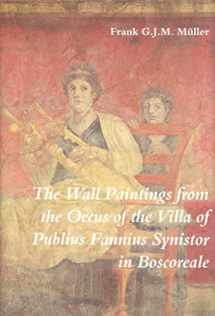
The Wall Paintings from the Oecus of the Villa of Publius Fannius Synistor in Boscoreale (Iconological Studies in Roman Art)
ISBN-13:
9789050632560
ISBN-10:
9050632564
Edition:
Illustrated
Author:
Mueller
Publication date:
1994
Publisher:
Brill
Format:
Hardcover
156 pages
Category:
Arts Collections
,
History
,
Arts History & Criticism
FREE US shipping
on ALL non-marketplace orders
Marketplace
from $7.78
USD
Marketplace offers
Seller
Condition
Note
Seller
Condition
Used - Like New
Book details
ISBN-13:
9789050632560
ISBN-10:
9050632564
Edition:
Illustrated
Author:
Mueller
Publication date:
1994
Publisher:
Brill
Format:
Hardcover
156 pages
Category:
Arts Collections
,
History
,
Arts History & Criticism
Summary
The Wall Paintings from the Oecus of the Villa of Publius Fannius Synistor in Boscoreale (Iconological Studies in Roman Art) (ISBN-13: 9789050632560 and ISBN-10: 9050632564), written by authors
Mueller, was published by Brill in 1994.
With an overall rating of 3.8 stars, it's a notable title among other
Arts Collections
(History, Arts History & Criticism) books. You can easily purchase or rent The Wall Paintings from the Oecus of the Villa of Publius Fannius Synistor in Boscoreale (Iconological Studies in Roman Art) (Hardcover) from BooksRun,
along with many other new and used
Arts Collections
books
and textbooks.
And, if you're looking to sell your copy, our current buyback offer is $0.3.
Description
The cycle of frescoes from the oecus or banqueting hall in the Villa of Publius Fannius Synistor in Boscoreale is generally interpreted as a portrait gallery of a Hellenistic dynasty. The iconological study presented in this volume offers historical and art-historical arguments against this supposition. On the basis of a meticulous iconographic analysis, the author arrives at an entirely new interpreta-tion. He demonstrates that the individual panels of which the fresco cycle is composed are not unica, as was hitherto assumed, but that they belong to an iconographical tradition which has left traces elsewhere in ancient art. On the basis of this new interpretation, the author comes to the conclusion that the fresco cycle from the Villa of Fannius was intended as an eloquent testimony to the cultural aspirations of a well-to-do Roman from the middle of the first century B.C.


We would LOVE it if you could help us and other readers by reviewing the book
Book review

Congratulations! We have received your book review.
{user}
{createdAt}
by {truncated_author}


